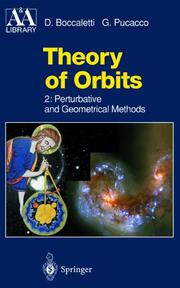Detailansicht
Theory of Orbits 2
Perturbative and Geometrical Methods, Astronomy and Astrophysics Library
ISBN/EAN: 9783540603559
Umbreit-Nr.: 1649533
Sprache:
Englisch
Umfang: xiv, 423 S., 62 s/w Illustr., 423 p. 62 illus.
Format in cm:
Einband:
gebundenes Buch
Erschienen am 19.11.1998
- Zusatztext
- Half a century ago, S. Chandrasekhar wrote these words in the preface to his 1 celebrated and successful book: In this monograph an attempt has been made to present the theory of stellar dy namics as a branch of classical dynamics - a discipline in the same general category as celestial mechanics. [. ] Indeed, several of the problems of modern stellar dy namical theory are so severely classical that it is difficult to believe that they are not already discussed, for example, in Jacobi's Vorlesungen. Since then, stellar dynamics has developed in several directions and at var ious levels, basically three viewpoints remaining from which to look at the problems encountered in the interpretation of the phenomenology. Roughly speaking, we can say that a stellar system (cluster, galaxy, etc.) can be con sidered from the point of view of celestial mechanics (the N-body problem with N' 1), fluid mechanics (the system is represented by a material con tinuum), or statistical mechanics (one defines a distribution function for the positions and the states of motion of the components of the system).
- Kurztext
- Theory of Orbits treats celestial mechanics as well as stellar dynamics from the common point of view of orbit theory, making use of concepts and techniques from modern geometric mechanics. It starts with elementary Newtonian mechanics and ends with the dynamics of chaotic motion. The two volumes are meant for students in astronomy and physics alike. Prerequisite is a physicist's knowledge of calculus and differential geometry. The first three chapters of this second volume are devoted to the theory of perturbations, starting from classical problems and arriving at the KAM theory, and to the introduction of the use of the Lie transform. A whole chapter treats the theory of adiabatic invariants and its applications in celestial mechanics and stellar dynamics. Also the theory of resonances is illustrated and applications in both fields are shown. Classical and modern problems connected to periodic solutions are reviewed. The description of modern developments of the theory of chaos in conservative systems is the subject of a chapter in which an introduction is given to what happens in both near-integrable and non-integrable systems. The invaluable help provided by computers in the exploration of the long-time behaviour of dynamical systems is acknowledged in a final chapter, where some numerical algorithms and their applications both to systems with few degrees of freedom and to large N-body systems are illustrated.
